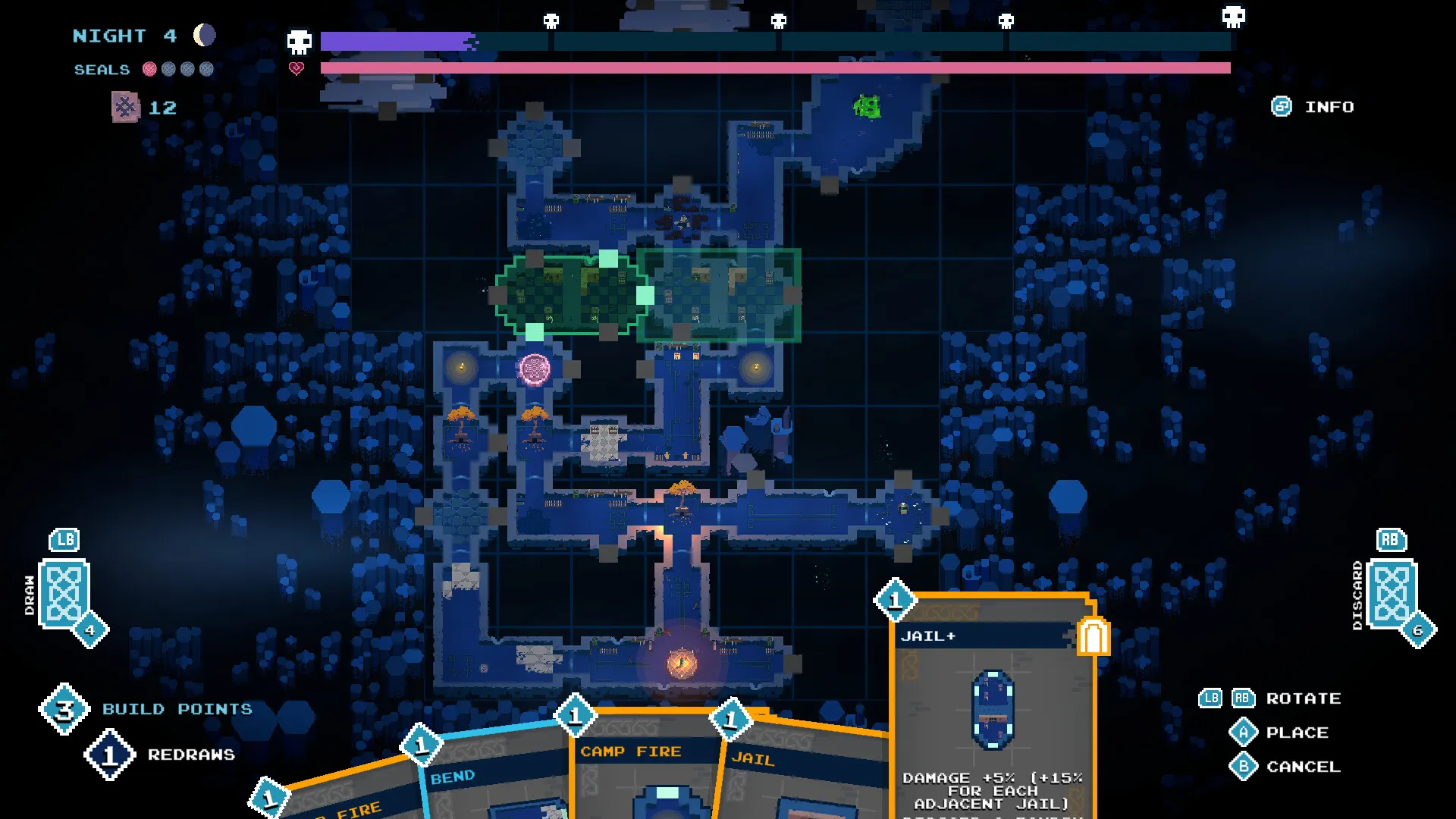Into the Restless Ruins presents a fascinating proposition, treating Scottish folklore not as mere set dressing but as an architectural blueprint. In a global market saturated with mythologies often flattened for mass consumption, this game embeds its cultural roots into its very foundation. It posits that to truly understand a legend, one must not only hear it but build it, piece by bloody piece.
We are cast as a seeker of the Harvest Maiden, a figure pulled from regional tales, but our quest is less about heroic combat and more about creation. The game’s core loop begins in silence, with the player laying down cards on a grid—each a room, a corridor, a trap.
This act of constructing the labyrinth you must then survive evokes a powerful sense of authorship. You are creating your own doom, a self-inflicted journey into a darkness of your own design, a game of foresight where survival depends on your ability to outwit the maze you just willed into existence.
The mechanics of this building phase are direct. With a limited pool of build points, you place dungeon components onto a grid. Each card presents a spatial puzzle, its shape and openings dictating the flow of your future path. Placing the exit and vital resource rooms becomes an exercise in strategic planning, a quiet meditation on the chaos to come.
The Cartography of Memory
The transition from builder to explorer is a stark one. The god-like overhead view vanishes, and you are thrust into the claustrophobic confines of your own creation. There is no map to guide you. This design choice is a deliberate rejection of modern gaming convenience, forcing a reliance on an older tool: memory.
This feels less like a simple difficulty modifier and more like a thematic statement. In a world saturated with data and GPS, the game insists that true navigation is an internal process. Getting lost is not a game failure but a personal one; a breakdown in the player’s own mental blueprint. The experience becomes a tense test of recollection, where every forgotten turn and misplaced room is a direct consequence of your earlier architectural decisions.
A dwindling torchlight provides constant pressure, its fading glow a ticking clock that punishes inefficiency and forces decisive movement. This temporal anxiety is paired with an unusual combat system. Your hero attacks automatically. The player’s role is one of positioning and avoidance, a dance of survival rather than an assertion of power. Enemies drop ‘Glimour,’ an ethereal resource that fuels the acquisition of new blueprint cards, tying the act of destruction directly back to the potential for future creation.
Digital Folklore and The Endless Tale
The game’s aesthetic choices reinforce its thematic commitment. The pixel art is not simply retro; it functions as a modern filter for ancient stories, creating a visual language that feels both nostalgic and timelessly grim. The world is explicitly rooted in Scottish mythology, featuring figures like the Hen Wife and the Wulver, while bosses are drawn from Gaelic legends.
This specificity, amplified by an atmospheric soundtrack and the inclusion of the Gaelic language, resists the cultural homogenization often seen in global entertainment. It presents its heritage without apology, creating a haunted, authentic space. This authenticity carries through to its structure, which mirrors the nature of oral tradition.
The dungeon floors are procedurally generated, ensuring the tale is never told the same way twice. Longevity comes from a deep well of unlockable content: over 100 cards, 40 passive Charms, and various weapons and relics. Players can further shape their experience with ‘Cantrips’—run modifiers that allow them to curate their own level of difficulty. This system of unlocks and modifiers turns the game into a storytelling engine, capable of generating endless variations on its core myth.
A System of Contradictions
The game finds its greatest strength in the relationship between its systems. True mastery comes from understanding room synergy—the art of placement. A well-designed dungeon, with looping paths that pass buff-granting Armouries or portals that create life-saving shortcuts, is far more effective than one built from individually powerful cards. Intelligent dungeon architecture, not brute force, is the key to victory. This focus on planning and foresight is the game’s most compelling feature.
Yet, this intellectual engagement sits in uneasy company with the game’s combat. The automated fighting system, while thematically coherent with a game about preparation, can feel passive and disconnected. For players accustomed to direct control, watching your character attack without input may feel monotonous, particularly during boss encounters which can devolve into simple tests of pattern memorization.
The no-map system, while brilliant in concept, can also produce moments of intense frustration. The game’s identity is built on this tension. It is a title that values intellect and memory above reflexes, a successful re-imagining of the deckbuilder where the primary puzzle is the environment itself. The deepest satisfaction comes not from winning a fight, but from creating a challenge and possessing the wisdom to solve it.
The Review
Into the Restless Ruins
Into the Restless Ruins is a brilliant thought experiment that successfully translates the structure of folklore into a playable system. Its core mechanic of building the dungeon you must then survive is an inspired marriage of strategy and theme. While the passive combat feels like a dissonant note in an otherwise atmospheric and intellectually rewarding composition, the game stands as a powerful example of how cultural identity can shape innovative design. It rewards foresight and memory, offering a unique and deeply satisfying challenge for the patient player.
PROS
- Inventive dungeon-building central mechanic.
- Deeply atmospheric world rooted in authentic folklore.
- Rewarding map-free exploration that tests player memory.
- Excellent replayability through procedural generation and unlocks.
CONS
- Automated combat feels passive and can become monotonous.
- Boss battles lack creativity.
- Relying purely on memory can lead to moments of frustration.
